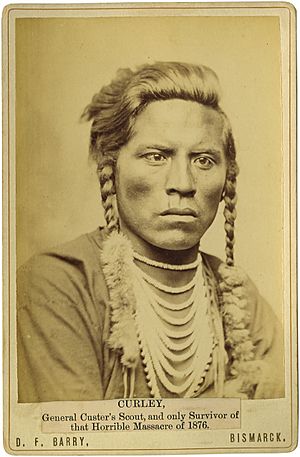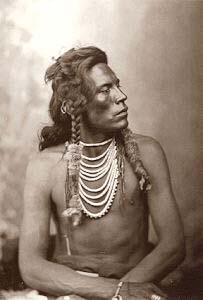Curly (scout) facts for kids
Ashishishe (born around 1856, died 1923), often called Curly, was a brave Crow scout for the United States Army. He is best known for being one of the few people on the U.S. side to survive the famous Battle of the Little Bighorn. Curly didn't fight in the battle himself. Instead, he watched it from a distance. He was the first person to tell the army that George Armstrong Custer's 7th Cavalry had been defeated. Over time, a story grew that he had fought in the battle and escaped. This led to different stories about what Curly actually did.
Contents
Life of Curly
Ashishishe was born in Montana Territory around 1856. His parents were Strong Bear and Strikes By the Side of the Water. His name, Ashishishe, might mean "curly" in the Crow language. Later in his life, his death record listed his name as "Bull Half White (Curly)".
Curly lived on the Crow Reservation near Pryor Creek. He married a woman named Bird Woman. On April 10, 1876, he joined the U.S. Army as an Indian scout.
Curly at the Battle of Little Bighorn
Curly served with Custer's 7th Cavalry Regiment during the Battle of the Little Bighorn in June 1876. Five other Crow scouts were also there: White Man Runs Him, Goes Ahead, Hairy Moccasin, White Swan, and Half Yellow Face.
Custer divided his soldiers into different groups. Half Yellow Face and White Swan fought with one group and White Swan was badly hurt. Curly, Hairy Moccasin, Goes Ahead, and White Man Runs Him were with Custer's group. However, they said they were told to leave before the main fighting began. Curly separated from the other scouts. He watched the battle between the Sioux and Cheyenne warriors and Custer's soldiers from a safe distance. When he saw that all of Custer's men were defeated, he rode off to share the sad news.
A day or two after the battle, Curly found an army supply boat called the Far West. It was at the meeting point of the Bighorn River and Little Bighorn River. He was the very first person to report that Custer's 7th Cavalry had been wiped out. He used sign language, drawings, and an interpreter to explain what happened.
At first, Curly never said he fought in the battle. He only said he watched it from far away. Many historians believed his first report because it was accurate. But as stories about "Custer's Last Stand" became popular, a legend grew. This legend said that Curly had fought bravely and escaped by disguising himself as a Lakota warrior. Later, Curly stopped denying this legend and even shared more detailed stories about his supposed escape. However, his family had a different story: they said he hid inside a horse after seeing Custer fall.
Later Life and Death
After 1884, Curly lived on the Crow Reservation near the Little Bighorn River, close to the battle site. He worked for the Crow Police. In 1886, he divorced Bird Woman and married Takes a Shield. Curly had one daughter, named Awakuk Korita ha Sakush, who was also known as Dora. For his service in the Army, Curly received a U.S. pension starting in 1920.
Curly died in 1923 from pneumonia. He was buried in the National Cemetery at the Little Bighorn Battlefield National Monument. This cemetery was only about a mile from his home.
What Curly Said Happened
Curly's earliest story about the battle was printed in a newspaper in 1876. He described how Custer's soldiers moved towards the Indian village. When they got close to the river, hidden warriors started shooting at them. Custer's men tried to fight back.
Curly saw many warriors riding out of the village. He also saw women and children leaving quickly. During the fight, Curly saw two of Custer's men die in the river. Custer realized it was too hard to cross the river. So, he moved his soldiers into the hills. But by then, many warriors had crossed the river and were attacking Custer's group from behind and from the side.
The soldiers tried to form a circle to defend themselves. They fought on foot while their horses were kept behind them. Curly said he was hidden in a ravine, so he couldn't see everything. He thought the battle started around 2:30 or 3:00 p.m. and lasted until almost sunset.
The warriors completely surrounded Custer's men. They charged many times, but the soldiers held their ground and fired back. Curly said the shooting was incredibly fast, like a continuous tearing sound. The soldiers used up all their ammunition and had to get more from their horses.
As the soldiers ran out of bullets, the warriors made a final big charge. The last of Custer's men were killed, many by arrows. Curly said Custer fought bravely for most of the battle but was mortally wounded about an hour before the end. Curly believed many warriors also died, possibly more than 600.
Curly said he escaped by wrapping his blanket around himself like a Sioux warrior. He walked through a gap in the warriors' lines. He thought they saw him but probably mistook him for one of their own or an allied warrior.
Curly's Own Words
Thomas Leforge, who was an interpreter, said that Curly always insisted he wasn't in the fight. Leforge interviewed Curly a few days after the battle. Curly told him, "I was not in the fight." When people congratulated him, he said, "I did nothing wonderful; I was not in it."
Curly explained that when the battle started, he was behind with other Crow scouts. He quickly moved about a mile away and watched the fight for a short time. Then he moved even farther away to another hill to watch again. He saw some horses running loose and caught two of them. But he later let them go because they slowed him down.
Leforge noted that writers made Curly into a hero, even though Curly himself didn't claim to be one. Curly couldn't read and spoke little English, so he didn't try hard to correct the stories. Some Sioux warriors called Curly a liar, saying no one with Custer escaped them. But Leforge said Curly was not a liar. Throughout his life, Curly humbly repeated what he told Lieutenant Bradley: "I did nothing wonderful; I was not in the fight." Leforge knew Curly from when he was a boy until he died. He described Curly as a good, quiet, and reliable scout who was highly respected by his people.
Images for kids




